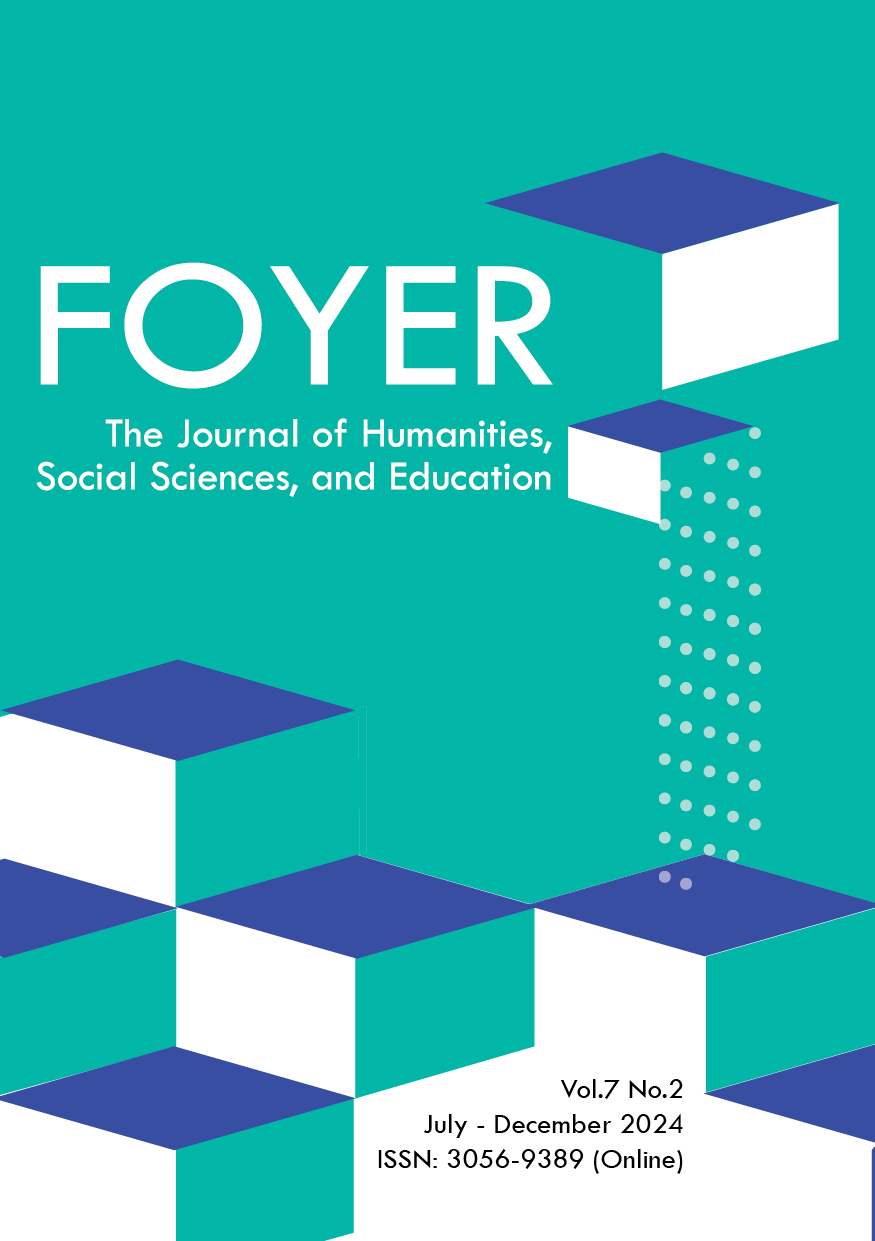การศึกษาผลสัมฤทธิ์ทางการเรียนและความพึงพอใจ ของนักศึกษาที่มีต่อการใช้สื่อการสอน การออกเสียงภาษาอังกฤษ กรณีศึกษาของนักศึกษาวิชาเอกภาษาอังกฤษ มหาวิทยาลัยสงขลานครินทร์ วิทยาเขตปัตตานี
คำสำคัญ:
แบบฝึกหัดการออกเสียงภาษาอังกฤษ, สัทศาสตร์ภาษาอังกฤษ, ผลสัมฤทธิ์ทางการเรียน, ความพึงพอใจของผู้เรียน, ผู้เรียนภาษาอังกฤษชาวไทยบทคัดย่อ
การวิจัยนี้มุ่งเน้นการเปรียบเทียบผลสัมฤทธิ์ทางการเรียนของนักศึกษาก่อนและหลังการใช้สื่อการสอนการออกเสียงภาษาอังกฤษตามหลักสัทศาสตร์ และศึกษาความพึงพอใจของนักศึกษาที่มีต่อการใช้สื่อการสอนเหล่านี้ โดยมีกลุ่มตัวอย่างที่เป็นนักศึกษาสาขาวิชาภาษาอังกฤษ ชั้นปีที่ 1 จากคณะมนุษยศาสตร์และสังคมศาสตร์ และคณะศึกษาศาสตร์ มหาวิทยาลัยสงขลานครินทร์ วิทยาเขตปัตตานี จำนวน 23 คน ซึ่งได้รับการเลือกแบบเจาะจงในการเป็นกลุ่มตัวอย่าง เครื่องมือที่ใช้ในการวิจัย ได้แก่ สื่อการสอนการออกเสียงภาษาอังกฤษ แบบทดสอบก่อนและหลังการเรียน และแบบสอบถามความพึงพอใจของนักศึกษา การวิเคราะห์สถิติที่ใช้รวมถึงค่าเฉลี่ย ค่าเบี่ยงเบนมาตรฐาน และการทดสอบ t-test
ผลการวิจัยพบว่า ผลสัมฤทธิ์ทางการเรียนของนักศึกษาดีขึ้นอย่างมีนัยยะที่สำคัญหลังการใช้สื่อการสอนการออกเสียงภาษาอังกฤษ (t = 2.083, p<0.05) และผลการวิเคราะห์คะแนนเฉลี่ยของระดับความพึงพอใจของผู้เรียนต่อการใช้สื่อการสอนการออกเสียงภาษาอังกฤษแสดงให้เห็นว่า ผู้เรียนได้ประโยชน์จากการใช้สื่อการสอนการออกเสียงภาษาอังกฤษอย่างสูง (ค่าเฉลี่ย 4.70), ผู้เรียนสามารถนำความรู้ไปใช้ในชีวิตประจำวันได้ (ค่าเฉลี่ย 4.83), และผู้เรียนมีทัศนคติที่ดีต่อภาษาอังกฤษ (ค่าเฉลี่ย 5.0) นอกจากนี้ มีแนวทางในการสร้างสื่อการสอนการออกเสียงภาษาอังกฤษที่ได้รับข้อเสนอแนะจากผู้ทรงคุณวุฒิ เช่น เพิ่มความหลากหลายในสื่อเพื่อดึงดูดความสนใจของผู้เรียน และควรมีการจัดทำสื่อในรูปแบบหนังสืออิเล็กทรอนิกส์ เพื่อเสริมสร้างประสบการณ์การเรียนรู้ที่มีประสิทธิภาพ
References
AbdAlgane, M., & Idris, S. A. M. (2020). Challenges of pronunciation to EFL learners in spoken English. Multicultural Education, 6(5) 193-203.
Anghirun, H. (2020). Improvement of English Major Students’ Pronunciation Using Natural Language Processing. Academic Journal for the Humanities and Social Science Dhonburi Rajabhat University, 3(1), 23-40.
Apichatabutra, P. (2011). Thai Learner Problems: Guidelines Based on Articulatory Pronunciation. Damrong Journal of the faculty of Archaeology Silpakorn University, 10(2), 1-22.
Burns, A., & Seidlhofer, B. (2019). Speaking and pronunciation. In An introduction to applied linguistics (pp. 240-258). Routledge.
Cedar, P., & Termjai, M. (2021). Teachers’training of English pronunciation skill through social media. Journal of education Naresuan university, 23(3), 32-47.
Chung, W. L. (2007). The effectiveness of explicit, implicit, and noticing instruction: Mandarin speakers’ perceptions and production of English sentence stress. ProQuest.
Derwing, T. M., & Munro, M. J. (2015). Pronunciation fundamentals: Evidence-based perspectives for L2 teaching and research. John Benjamins.
Gilakjani, A. P. (2011). A study on the situation of pronunciation instruction in ESL/EFL classrooms. Journal of studies in education, 1(1), 1-15.
Gilakjani, A. P. (2016). What factors influence the English pronunciation of EFL learners?. Modern Journal of Language Teaching Methods, 6(2), 315.
Hamzah, M.H.B. (2014). The role of explicit phonetic instruction in pronunciation teaching in ESL setting. Research Gate. https://www.researchgate.net/publication/303336384_THE_ROLE_OF_EXPLICIT_PHONETIC_INSTRUCTION_IN_PRONUNCIATION_TEACHING_IN_ESL_SETTINGS
Harmer, J. (2001). The practice of English language teaching Longman.
Hassan, E. M. I. (2014). Pronunciation problems: A case study of English language students at Sudan University of Science and Technology. English Language and Literature Studies, 4(4), 31.
Isaacs, T., Trofimovich, P., & Foote, J. A. (2018). Developing a user-oriented second language comprehensibility scale for English-medium universities. Language Testing, 35(2), 193-216.
Kanokpermpoon, M. (2007). Thai and English consonantal sounds: A problem or a potential for EFL learning?. ABAC journal, 27(1), 57-66.
Kanoksilapatham, B. (2016). Towards Global English Horizons. LEARN Journal: Language Education and Acquisition Research Network, 9(2), 44-48.
Kissling, E. M. (2013). Teaching pronunciation: Is explicit phonetics instruction beneficial for FL learners?. The modern language journal, 97(3), 720-744.
Kukeartkarn, K. (2017). The Effects of Phonics of EFL Students’ English Recognition and Pronunciation [Doctoral dissertation, Huachiew Chalermprakiet University].
Liu, Q., & Fu, Z. (2011). The Combined Effect of Instruction and Monitor in Improving Pronunciation of Potential English Teachers. English Language Teaching, 4(3), 164-170.
Low, E. L. (2021). EIL pronunciation research and practice: Issues, challenges, and future directions. RELC Journal, 52(1), 22-34.
Pairor, S., & Phusawisot, P. (2022). The Use of Phonological Awareness Instruction in Improving English Word Reading Ability of Thai Primary Students [Doctoral dissertation, Mahasarakham University].
Peerachachayanee, S. (2022). Into intelligible pronunciation features of Thai English in English as a lingua franca context. The New English Teacher, 16(2), 81-114.
Piyamat, B., & Deekawong, K. (2021). Phonological Variations and Problems in English Pronunciation among Thai EFL Learners: A Case Study of Undergraduate Students at Huachiew Chalermprakiet University. Liberal Arts Review, 16(1), 70-84.
Plailek, T. (2021). Pronunciation problems and factors affecting English pronunciation of EFL students. Turkish Journal of Computer and Mathematics Education (TURCOMAT), 12(12), 2026-2033.
Pourhossein Gilakjani, A. (2016). English pronunciation instruction: A literature review. International Journal of Research in English Education, 1(1), 1-6.
Prashant, P. D. (2018). Importance of pronunciation in English Language communication. Pronunciation and Communication, 7(2), 16-17.
Ronnakiat, N. (2012). Application of phonetics to teaching English pronunciation. Thammasat University Press.
Sahatsathatsana, S. (2017). Pronunciation problems of Thai students learning English phonetics: A case study at Kalasin University. Journal of Education, 11(4), 67-84.
Saito, K., & Plonsky, L. (2019). Effects of second language pronunciation teaching revisited: A proposed measurement framework and meta‐analysis. Language Learning, 69(3), 652-708.
Singhanuwananon, M. S. (2018). Unintelligility: problematic linguistic areas of pronunciation and their impact on self-confidence in English speaking among Thai engineering students [Doctoral dissertation, Thammasat University].
Sirichote, P., & Kanokpermpoon, M. (2022). Investigation Into Thai EFL Learners ‘English Pronunciation Using Microsoft Reading Progress [Doctoral dissertation, Thammasat University].
Suntornsawet, J. (2019). Problematic Phonological Features of Foreign Accented English Pronunciation as Threats to International Intelligibility: Thai EIL Pronunciation Core. Journal of English as an International Language, 14(2), 72-93.
Taladngoen, U., Pinsak, J., & Chuenchomnakjad, S. (2020). Pronunciation learning strategies used among Thai EFL tertiary students with different self-evaluated pronunciation abilities. Suranaree Journal of Social Science, 14(2), 99-117.
Tanthanis, T. (2012). A Study of English Pronunciation Problems and English Pronunciation Leaning Strategies of Third Year Interdisciplinary Studies Students of Thammasat University. Language and Linguistics, 31(1), 81-102.
Winaitham, W., & Suppasetseree, S. (2012). The investigation of English pronunciation errors and factors affecting English pronunciation of Thai undergraduate students. Silpakorn Educational Research Journal, 4(2), 304-320.
Wongsuriya, P. (2020). Improving the Thai Students’ Ability in English Pronunciation through Mobile Application. Educational Research and Reviews, 15(4), 175-185.
Yokomoto, K. (2017). EFL teachers’ interests and beliefs as determiners of their instructional decisions in the teaching of pronunciation. Language Teacher Cognition Research Bulletin 2017, 51-68.
Downloads
เผยแพร่แล้ว
How to Cite
ฉบับ
บท
License

This work is licensed under a Creative Commons Attribution-NonCommercial-NoDerivatives 4.0 International License.


